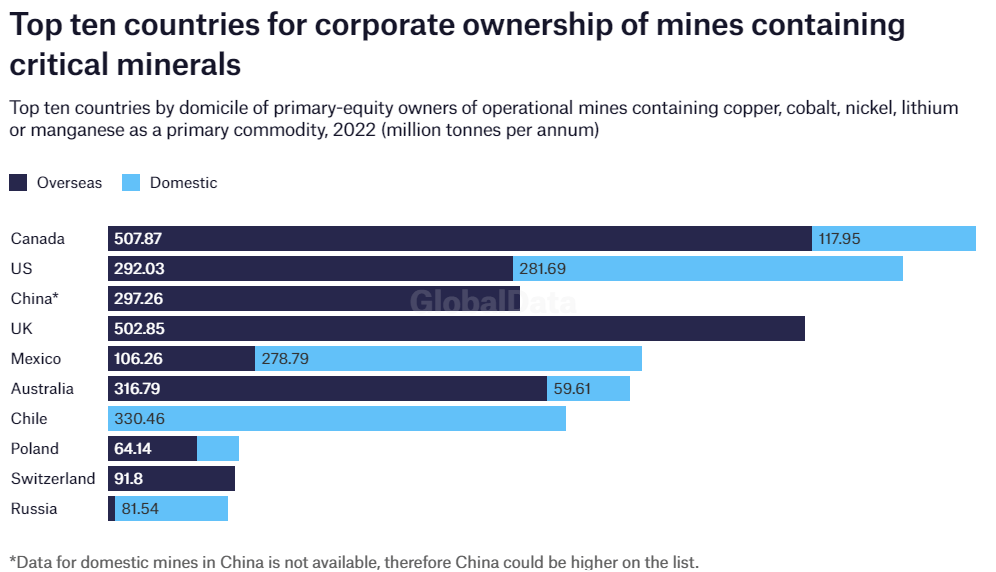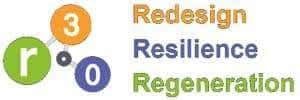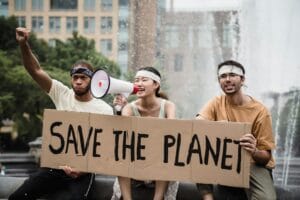Critical minerals are minerals and metals that are essential for the economic growth and national security of a country (IEA, n.d.). Globally, the demand for critical minerals, especially rare metals, has been driven by the production and consumption of highly technical devices for personal, commercial, and industrial uses. Lately, they are an essential raw material for the growing deployment of clean energy technologies within the energy transition landscape. Some of the major critical minerals currently in high demand include copper, lithium, nickel, cobalt, graphite, and rare earth elements (IEA, n.d.).
Rare earth elements are essential for electric vehicles, wind turbines, energy-efficient lighting, and other items necessary for the energy transition. Cobalt is used in rechargeable battery electrodes and superalloy manufacturing. Copper is widely utilised in both clean energy technologies and traditional industries. Lithium’s use is rapidly increasing in electric vehicles and lithium-ion batteries. Nickel is versatile, being used in various clean energy technologies and traditional industries such as steel.
However, while these minerals are indispensable to a low-carbon future, their extraction and processing can carry significant environmental and social costs.
A new perspective
Many national strategies focus narrowly on ensuring supply security but pay less attention to the broader systems they affect. They don’t take into account ecosystems, local communities, and global supply chains. This is where a new perspective is needed.
THRIVE Project proposes a shift. It argues that to secure a truly sustainable future, critical-mineral strategies must move beyond short-term resource management. These strategies should embrace a thrivable model, one built on Context-Based Metrics and Systems Thinking.
By applying these two Foundational Focus Factors early in policy design, countries can ensure their strategies address not only the “how much” of mineral supply, but the “how well”.
Many countries are devising a critical mineral strategy, which will be key to ensuring an uninterrupted supply. However, these policies do not consistently promote and mandate sustainable and responsible extraction, processing, and use of these minerals. Ecosystems depend on the lands from which these critical minerals are extracted. Misuse and exploitation of these lands will result in environmental degradation, biodiversity loss, and harm to the livelihoods of indigenous communities (IEA, 2022).
What is a Critical Mineral Strategy?
Critical Mineral Strategies outline how resources will be exploited and used. They guide each country’s approach to availability and reliability, often relying on complex global supply chains (IEA, 2022).
Beyond securing supply, such strategies also reflect economic and geopolitical ambitions (IEA Policies Database, n.d.). For instance:
The United States’ Goals: Secure supply chains vital for national security and economic prosperity; reduce dependence on foreign sources; promote domestic mining, processing, and recycling.
Canada’s Goals: Ensure a stable supply for domestic industries; enhance opportunities for Indigenous communities; promote sustainable mining practices.
China’s Goals: Maintain its dominant global market position; ensure steady supply for high-tech and green-energy sectors; leverage resources for geopolitical influence.
The European Union’s Goals: Secure sustainable and ethical sourcing; reduce import dependence; ensure supply for key industries.

Source: Bindman, 2023
In September 2023, the International Energy Agency hosted the first-ever Critical Minerals and Clean Energy Summit. The goal was to promote the secure, sustainable, and responsible supply of raw materials (IEA, 2023). However, aligning trade agreements with environmental and social safeguards remains vital to prevent the same extractive patterns that have long harmed ecosystems and vulnerable communities (WEF, 2024).
Incorporating THRIVE’s principles from the start transforms critical-mineral strategies from resource-security plans into regenerative roadmaps. They allow policymakers to view the mineral economy not as an isolated sector, but as part of an interconnected system. In this system, environmental health, human well-being, and economic resilience thrive together.
Challenges in Using Critical Minerals
The extraction, processing, and use of critical minerals are associated with multifaceted sustainability challenges. These include environmental damage, socio-economic risks, and geopolitical disputes (Sustainable Fitch, 2023).
Biodiversity loss
The environmental issues involved in mineral extraction include habitat and landscape destruction, biodiversity loss, water contamination, and air pollution. The extraction and processing of critical minerals takes place over large expanses of land and requires substantial resource use. Open-pit or underground mining has the potential to destroy landscapes, resulting in soil erosion and water pollution. Land degradation from deforestation can cause large biodiversity loss (AMCEN, 2023).
Water contamination and depletion
The extraction and processing of ore, as well as transporting it in slurry pipelines, are extremely water-intensive processes (MIT, 2022). This can result in severe freshwater contamination, affecting humans, animals, and crops in the area. It may also lead to water scarcity in some regions. This would lead to competition for water resources with other sectors, such as agriculture. Over 50% of today’s lithium resources are mined from areas with high water stress (AMCEN, 2023). One of the largest sites for copper extraction is Chile’s Atacama Desert, which is the driest desert on Earth (MIT, 2022).
Hazardous waste
Another major concern is the accumulation of hazardous waste from mineral extraction. Thus, resulting in mountains of waste created by mining companies that contain hazardous chemicals (IEA, 2021). In the U.S., copper mining contributes the largest proportion of metal mining and processing waste (EPA, 2023). Waste is typically stored in isolated areas called tailing ponds. These ponds sometimes leak or even completely fail, releasing toxins into nearby water systems (MIT, 2022).
Air pollution and greenhouse gas emissions
Mining and refining of critical minerals are also energy-intensive processes and pollute the air with greenhouse gas emissions (IEA, 2021). Over the last decade, the average amount of minerals needed for one unit of power generation has increased significantly (AMCEN, 2023). This is contradictory to the purpose of reducing climate change. It offsets the environmental benefits of clean energy technologies.
Unsafe working conditions and health problems
With the world moving towards the target of net-zero carbon emissions, the demand for rare earth elements is growing. Many nations are struggling with how to secure supplies to match the increasing demand (Willige, 2025). Consequently, this results in the exploitation of the countries from which the critical minerals are mined. Mining is a dangerous process and provides unsafe working conditions for workers. It can also lead to health problems, including cancers and respiratory diseases (MIT, 2022). Furthermore, the surrounding communities also face the consequences of environmental damage, while gaining zero direct benefit from it. Child labour and gender-based violence have also been reported in mines of sub-Saharan African countries (GIZ, 2020)
Land-use exploitation
Land-use issues also result in conflicts with local communities and often unfairly affect low-income or developing areas (MIT, 2022). The mineral-rich countries are often not the beneficiaries of economic growth (IEA, 2023). For example, the Democratic Republic of Congo, which produces 74% of cobalt, has no strategic plans around critical minerals. It has a lack of environmental standards and no involvement in international coordination mechanisms. Hence, it relies only on global organisations that mine and process the cobalt to follow sustainable practices (IEA 2022).
Here is where Systems Thinking matters. The mineral supply chain is not isolated; it links extraction, processing, recycling, labour, communities, ecosystems, and global markets. Without seeing those links, a strategy may look secure but still be unsustainable for ecosystems or societies.
Using Critical Mineral Strategy to Minimise Negative Impacts
A robust critical-mineral strategy can help minimise the negative impacts. This is where THRIVE’s emphasis on Context-Based Metrics sustainability also comes in. Since sustainability is not one-size-fits-all, local contexts (ecological, social, and economic) must shape how policy is designed and applied (AMCEN, 2023).
When starting a project, researchers must extensively study the landscape to ensure biodiversity hotspots or sensitive lands are not affected. They can also undertake life-cycle assessments (LCAs) to understand environmental conditions and the consequences of proposed actions (Zapp et al., 2022). If project planners integrate LCA principles at the early stages, they can better anticipate potential impacts. They can also effectively allocate budgets for sustainable practices.
When it comes to resource efficiency, sustainable policies should minimise the impact on Finite Resources such as fresh water. Efficient resource management and research into alternative materials, technologies, and recycling methods can make their use more sustainable. Mineral-rich and low-income countries should also be provided support, like capacity building and technology transfer, in building and implementing sustainable policies. Leaders should encourage countries to build their own renewable sectors in the energy transition. This helps retain the benefits of energy transition and promotes control of resources domestically.
Using best practices
Critical mineral strategies should incorporate circular economy practices that support the re-use and recycling of critical minerals and reduce the need for primary extraction. In 2018, Apple used a robot to dismantle 200 iPhones an hour to extract the critical minerals from used iPhones. This process has the potential to recover 1,900kg of aluminium, 770kg of cobalt, 710 kg of copper, and many other critical minerals from 100,000 iPhones (Balaram, 2019).
Switching to low-carbon electricity during the energy-intensive processing phase and investing in energy-efficient technology can significantly reduce the emissions footprint in the near term (IEA, 2021). Reducing diesel use during transportation from the mining site to the processing site can also be an important element of improvement (IEA, 2021).
By adopting the THRIVE Framework, strategy-makers can view the mineral-supply chain end-to-end, from extraction to use and disposal. Designing policy using this holistic view helps ensure that outcomes truly align with sustainability rather than just extraction.
moving forward
There are various regulations and policies that countries are putting in place to ensure the sustainable use and development of critical mineral resources. These regulations and policies should be sustainable and have the intention of minimising the negative environmental effects and harm caused to society.
A key aspect of implementing good practices at the end of a project is ensuring remediation of abandoned mine sites and community consultation. The safe disposal of waste and the use of advanced treatment technologies are necessary to prevent pollution. So, this will protect the environment and safeguard human health (Lottermoser, 2011).
Socio-economic factors to consider while making strategic mineral policy should include job creation, fair wages, and community development. Many critical minerals are concentrated in a few countries, most often low-income or developing countries. This can cause the exploitation of resources and labour. Many developing countries rely heavily on export revenue from minerals. This has often led to underinvestment in other aspects of economic development. As a result, the economy is more vulnerable to changes in global commodity prices and demand. Effective governance policies should be put in place to ensure that mining revenues are used for the benefit of the local community and to support the diversification of the economy (IEA, 2021).
From a THRIVE perspective, moving forward also means measuring performance in context (Context-Based Metrics). It means recognising the system interconnections (Systems Thinking). It means asking: Are the local ecosystems, the workers, the communities, the supply chains, the end-users, and the recyclers all part of the strategy? Are their impacts measured in context, not just globally averaged? Are we designing for regeneration and thrivability, not just extraction?
Why focus on Critical Mineral Strategy?
The sustainability of critical mineral strategies and policies depends on various factors such as how they are designed, implemented, and managed.
As critical minerals can help the world achieve a net-zero energy future, it is important that we focus on sustainable mining and refining practices. In order to meet the Paris Agreement goals, the proportion of clean energy technologies to total energy production rises significantly from 2030-2050 to over 40% for copper and rare earth elements, 60-70% for nickel and cobalt, and almost 90% for lithium (AMCEN, 2023).
On one hand, environmental degradation, health hazards, and exploitation of labour are harmful impacts. On the other hand, critical minerals provide opportunities to resource-rich nations in terms of job creation and increased export earnings. So, it is important to implement policies and regulate the critical mineral supply chain.
International collaboration between countries and organisations can help address sustainability challenges by playing a key role in standardising environmental and social standards. Greater pressure from investors and end-use consumers is required to expand sustainability initiatives (IEA, 2021).
achieving the UN Sustainable Development Goals (SDGs) Through Critical Mineral Strategy
The United Nations’ Sustainable Development Goals (SDGs) are a set of goals guiding nations, organisations, and businesses (UN, n.d.). Renewable energy and economic growth (for example, SDG7: Affordable and Clean Energy) are essential to creating a more sustainable future (UN, n.d.). A well-designed critical mineral strategy can support SDG7 by ensuring a reliable supply of the minerals necessary for clean energy technologies.
However, SDG7 alone is not enough. If mineral extraction occurs without respect for ecosystems, community rights, and regenerative values, then we risk trading one set of harms for another. That’s why a deeper approach is needed, one grounded in THRIVE Project’s vision of thrivability, beyond sustainability. It means going beyond “can we supply enough minerals?” to ask: “Can we supply them in ways that regenerate ecosystems, respect communities, and create long-term value?”
A Thrivable Framework
A trans-disciplinary and holistic approach is needed to investigate and predict the outcomes of initiatives in policies and energy transition that we make today. THRIVE Project has followed this approach and developed the THRIVE Framework.
This framework is built on 12 Foundational Focus Factors, which transition from linear to circular economy and trans-disciplinary systems thinking to solve the complex challenges we face in transitioning to more innovative and sustainable energy sources. It emphasises Context-Based sustainability: measuring environmental, social, and economic performance relative to ecological thresholds, community norms and local systems. It also emphasises Systems Thinking: recognising how the parts of a system (extraction, supply chain, recycling, communities, ecosystems, end-use) are interconnected and must be managed holistically.
The goal is not simply to do “less bad” but to support a future that is thrivable, where all people fulfil their potential in a socially responsible and regenerative way, and the planet thrives alongside.
Final word
The rush to secure critical minerals for the energy transition is understandable. But if we do not embed THRIVE’s Framework, we risk merely shifting the burden rather than solving the problem. THRIVE Project invites policy-makers, industry players, and civil society to embrace a thrivable approach, one that secures critical minerals, supports clean energy and builds resilient, regenerative systems for people and planet.
To know more about how THRIVE Project is contributing to the research, education, and advocacy for a thriving world, visit our website. To learn of our updates on blogs, journals, podcasts, webinars, and events, sign up for our newsletter.























